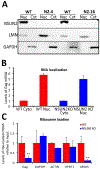Epitranscriptomic Addition of m5C to HIV-1 Transcripts Regulates Viral Gene Expression
- PMID: 31415754
- PMCID: PMC6714563
- DOI: 10.1016/j.chom.2019.07.005
Epitranscriptomic Addition of m5C to HIV-1 Transcripts Regulates Viral Gene Expression
Abstract
How the covalent modification of mRNA ribonucleotides, termed epitranscriptomic modifications, alters mRNA function remains unclear. One issue has been the difficulty of quantifying these modifications. Using purified HIV-1 genomic RNA, we show that this RNA bears more epitranscriptomic modifications than the average cellular mRNA, with 5-methylcytosine (m5C) and 2'O-methyl modifications being particularly prevalent. The methyltransferase NSUN2 serves as the primary writer for m5C on HIV-1 RNAs. NSUN2 inactivation inhibits not only m5C addition to HIV-1 transcripts but also viral replication. This inhibition results from reduced HIV-1 protein, but not mRNA, expression, which in turn correlates with reduced ribosome binding to viral mRNAs. In addition, loss of m5C dysregulates the alternative splicing of viral RNAs. These data identify m5C as a post-transcriptional regulator of both splicing and function of HIV-1 mRNA, thereby affecting directly viral gene expression.
Keywords: 5-methyl cytosine; HIV-1; NSUN2; RNA modification; RNA splicing; epitranscriptomic; translation of mRNA.
Copyright © 2019 Elsevier Inc. All rights reserved.
Conflict of interest statement
Declaration of Interests
The authors declare no competing interests.
Figures





References
Publication types
MeSH terms
Substances
Grants and funding
LinkOut - more resources
Full Text Sources
Molecular Biology Databases
Research Materials
Miscellaneous

